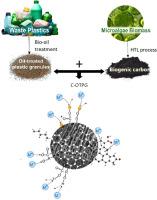一种从水溶液中高效回收金属的新型吸附剂:碳包覆油处理塑料颗粒作为资源保护的可持续途径
IF 10.9
1区 环境科学与生态学
Q1 ENGINEERING, ENVIRONMENTAL
引用次数: 0
摘要
本研究研究了碳包覆油处理塑料颗粒(COTPG)的发展,通过将生物质衍生的生物炭涂覆在由废旧塑料制成的颗粒上,创造了一种用于从水溶液中回收金属的新型吸附剂。我们假设,将生物炭的功能表面化学与塑料颗粒的结构优势结合起来,可以产生一种低成本、选择性和可扩展的吸附材料,能够有效地去除水中的过渡金属离子,如Cu 2 +和Fe 2 +。结合密度泛函理论(DFT)计算、连续流吸附测试和UV-Vis光谱,我们评估了COTPG对铜(Cu 2 +)和铁(Fe 2 +)离子的吸附性能和机理。结果表明,COTPG对Cu 2 +具有很强的亲和力,明显优于传统的吸附剂,如沙子和玻璃珠。其对Cu 2 +的吸附能力高于Fe 2 +,反映出与生物炭表面官能团的相互作用更强,尤其是在富π多芳区。此外,与传统材料相比,COTPG证明了Fe 2⁺的吸附性增强,强调了它在去除各种金属离子方面的通用性。DFT分析证实,生物炭上含氧和含氮官能团有利于络合和离子交换,而其多芳族结构有助于阳离子-π相互作用,增强了Cu 2 +的选择性。这项研究不仅证明了COTPG作为一种有前途的金属回收吸附剂的有效性,而且强调了它在促进资源保护和回收工作中的作用。本文章由计算机程序翻译,如有差异,请以英文原文为准。

A novel adsorbent for efficient metal recovery from aqueous solutions: Carbon-coated oil-treated plastic granules as a sustainable approach to resource conservation
This study investigates the development of carbon-coated oil-treated plastic granules (C![]() OTPG) by coating biochar derived from biomass onto granules made from end-of-life plastics, creating a novel adsorbent for metal recovery from aqueous solutions. We hypothesize that combining biochar’s functional surface chemistry with the structural advantages of plastic granules can result in a low-cost, selective, and scalable adsorbent capable of effectively removing transition metal ions such as Cu²⁺ and Fe²⁺ from water. Combining density functional theory (DFT) calculations, continuous-flow adsorption tests, and UV–Vis spectroscopy, we evaluated the adsorption performance and mechanisms of C
OTPG) by coating biochar derived from biomass onto granules made from end-of-life plastics, creating a novel adsorbent for metal recovery from aqueous solutions. We hypothesize that combining biochar’s functional surface chemistry with the structural advantages of plastic granules can result in a low-cost, selective, and scalable adsorbent capable of effectively removing transition metal ions such as Cu²⁺ and Fe²⁺ from water. Combining density functional theory (DFT) calculations, continuous-flow adsorption tests, and UV–Vis spectroscopy, we evaluated the adsorption performance and mechanisms of C![]() OTPG for copper (Cu²⁺) and iron (Fe²⁺) ions. Results demonstrate that C
OTPG for copper (Cu²⁺) and iron (Fe²⁺) ions. Results demonstrate that C![]() OTPG exhibits a strong affinity for Cu²⁺, significantly outperforming traditional adsorbents such as sand and glass beads. Its adsorption capacity for Cu²⁺ was higher than for Fe²⁺, reflecting stronger interactions with functional groups on the biochar surface, particularly in the π-rich polyaromatic regions. Additionally, C
OTPG exhibits a strong affinity for Cu²⁺, significantly outperforming traditional adsorbents such as sand and glass beads. Its adsorption capacity for Cu²⁺ was higher than for Fe²⁺, reflecting stronger interactions with functional groups on the biochar surface, particularly in the π-rich polyaromatic regions. Additionally, C![]() OTPG demonstrated enhanced Fe²⁺ adsorption compared to conventional materials, emphasizing its versatility in removing various metal ions. DFT analysis confirmed that oxygen- and nitrogen-containing functional groups on biochar facilitate complexation and ion exchange, while its polyaromatic structure contributes to cation-π interactions, reinforcing Cu²⁺ selectivity. This study not only demonstrates the effectiveness of C
OTPG demonstrated enhanced Fe²⁺ adsorption compared to conventional materials, emphasizing its versatility in removing various metal ions. DFT analysis confirmed that oxygen- and nitrogen-containing functional groups on biochar facilitate complexation and ion exchange, while its polyaromatic structure contributes to cation-π interactions, reinforcing Cu²⁺ selectivity. This study not only demonstrates the effectiveness of C![]() OTPG as a promising adsorbent for metal recovery but also highlights its role in advancing resource conservation and recycling efforts.
OTPG as a promising adsorbent for metal recovery but also highlights its role in advancing resource conservation and recycling efforts.
求助全文
通过发布文献求助,成功后即可免费获取论文全文。
去求助
来源期刊

Resources Conservation and Recycling
环境科学-工程:环境
CiteScore
22.90
自引率
6.10%
发文量
625
审稿时长
23 days
期刊介绍:
The journal Resources, Conservation & Recycling welcomes contributions from research, which consider sustainable management and conservation of resources. The journal prioritizes understanding the transformation processes crucial for transitioning toward more sustainable production and consumption systems. It highlights technological, economic, institutional, and policy aspects related to specific resource management practices such as conservation, recycling, and resource substitution, as well as broader strategies like improving resource productivity and restructuring production and consumption patterns.
Contributions may address regional, national, or international scales and can range from individual resources or technologies to entire sectors or systems. Authors are encouraged to explore scientific and methodological issues alongside practical, environmental, and economic implications. However, manuscripts focusing solely on laboratory experiments without discussing their broader implications will not be considered for publication in the journal.
 求助内容:
求助内容: 应助结果提醒方式:
应助结果提醒方式:


